 IJN armoured aircraft carrier.
IJN armoured aircraft carrier. WW2 IJN Aircraft Carriers:
Hōshō | Akagi | Kaga | Ryūjō | Sōryū | Hiryū | Shōkaku class | Zuihō class | Ryūhō | Hiyo class | Chitose class | Mizuho class* | Taihō | Shinano | Unryū class | Taiyo class | Kaiyo | Shinyo | Ibuki |The world’s largest aircraft carrier
The third member of the Yamato super-battleships, IJN Shinano (信濃 – A province in Central Japan) had an uncertain fate before it was decided to convert her as an aicraft carrier, capitalizing on the best armoured hull in the world at the time, and record displacement. It was estimated, rightly so, that her protection would make her almost impervous to air attack. When decision was made after Midway, she was converted in two years, until completed on November 1944. At 69,151 tonnes (compared to 50,000 for the Midway class in Construction, 31,000 for the Essex class) she was indeed, and until the arrival of USS Forrestal in 1953 (80,000), the largest aircraft carrier ever built, “largest” being taken here as a traditional displacement reference, not size. However her career was dramatically short.
Yamato’s class second group
IJN Shinano was ordered through the 1939 initiative, and 4th naval armament supplement program to extent the capacities of the IJN in the Pacific. So she was designed as a follow-up of the Yamato class, with little changes but thinner armour in some places and more AA compared to the original first pair. She was laid down at Yokosuka NyD on 4 May 1940, as the third battleship of the Yamato class, 1st of the second group authorized in the 1939 program. For memory, her two earlier sisters were ordered in the 1937, 3rd naval armament propgram. Design was finalized in late 1937 but progressed after the lead vessel was laid down in November 1937, IJN Musashi in April 1938. Both were launched in late 1940, IJN Yamato being completed a few days after the start of Hostilities.
There was in fact a third group, or pair, derived from the Yamato design, authorized in the 5th, 1942 supplementary program, unnamed and just known as “N°797”, without any known change compared to the Shinano sub-class. Her sister ship was not even considered, and N°797 was cancelled, as well as a fourth pair: This was known as N°798 and 799. At least they received some substantial upgrades compared to the Yamato class and were significantly larger, planned to carry six (three twin turrets) with six to eight 20-in cannons (508 mm) and 18-in (460 mm) side armour, but all three were cancelled.
It seems that in early 1942 the “aviation lobby” won the day against the more conservative faction of the IJN. The last class was later dubbed by historians “super-yamato” and proceeded on the assumption that as far as the Yamato class would be known by US Intel, larger ships would be built in response for the USN, which logically needed to be dealt with in advance, keeping a qualitative edge; These “super Yamato” were also known as project 150, but they are beyond the scope of this article.
In December 1941, after hostilities started, the construciton of IJN Shinano and her unnamed sister “N°111” was supended. They were waiting for their fate. The first, already being laid down on 7 November 1940, had completion planned in 1943 if unchanged, despite labor and material shortages. It was chosen to suspend her whereas her sister was just 30% complete in early 1942. It was decided not to proceed to completion or conversion to have her scrapped eventually in her yard, the recycled material being reused for more important ships, notably aircraft carriers.
Conversion decision

Original hull lines reconstituted by ONI, inverted. Click to see the HD ☍Src
decision to convert her was not to wait after after the gradual loss of the Kido Butai (1st air fleet) at Midway and the Solomons. Indeed, the need for aircraft carrier instead of battleships was revealed with the experience of 1940 already, especially the Taranto raid, which confirmed to the admiralty the primacy of naval air power. Not only this reinforced the Pearl Habor attack plan, but by December 1941 IJN Shinano in construction since May 1940 was 50% complete when all work was suspended. It’s only after battle at Midway that decision was taken to complete her into a new design of armoured aircraft carrier.
Completed remarkably fast after launch on 8 October 1944, by 19 November 1944 for initial trials, commissioned but not even yet operational, IJN Shinano was riddled by problems but the admiralty pressed on her departure on 28 November for a first mission anyway, with four destroyers in escort. This sortie was picked up on the 29th on her way from Yokosuka to Kure for outfitting, by USS Archerfish’s radar, and the latter took position for a deadly spread; In all, four out of six torpedoes struck Shinano. the crew, although confident at first to save her, proved grossly incompetent and could not contain the flooding. She sank after 7.5 hours of internal battle, turning over with most of her crew off Inamba Island. However many issues that led to her demise were linked to her rushed completion. Let’s dive deep into this:
Design of the conversion
As for Yamato and Musashi, construction was originally a closely guarded secret with a tall fence erected around the graving dock and workers confined for the construction time to the yard compound. Any mention of their work was punishable by death. Shinano lacked photos because she was never officially photographed during that phases, and rarely after completion due to her short career. The only two known photos are from 1 November 1944 (by a passing by Boeing B-29 Superfortress used for reconnaissance, from 9,800 meters (32,000 ft)) and ten days afterwars by a civilian in a harbor tug during her initial sea trials in Tokyo Bay. So basically both were “stolen photos”.
In December 1941, her construction as said above was temporarily suspended, pending a decision. Completion as a battleship was pushed back in 1945, and it was now clear for the Admirakty that capital ship had lost the battle to aviation (at least the now “young faction” led by Admiral Yamamoto had a strong point). The navy also wanted clear up the large drydock to repair her sister ship ASAP, and it was considered scrapping her hull or finish the hull to launch it, clear the drydock, and complete her later. The latter was chosen, but with a much reduced workforce and so it took about two years to proceed. This left plenty of time to work out her possible redesign.
By July 1942, Midway however had changed the game. The Kido Butao, spearpoint of the IJN, has been gutted, and top brass ordered the unfinished hull to be converted into an aircraft carrier, at that stage 45% complete. The lower deck and most of her machinery were complete, but the top was far from complete and several decks were missing. The main deck, lower side armor, and upper side armor were still to be completed, forward barbettes nearly finished however were a liability for the conversion and a headache for engineers.
Thus, knowing the numerous limitations of the conversion, it was decided to complete her as a “heavily armored support carrier”, so basically an impregnable reserve aircraft carrier with plenty fuel and ordnance in support of the new planned carrier fleet, composed of Taiho-class armoured carrier line and a second line formed or unarmoured carriers of the Unryu class. The Shinano would have been in a third line, supplying as required either of the carriers. Engineers took the Taiho design as a starting point and worked around the clock to fir a single, well protected hangar and large flying deck. If internal space was just enough for 47 planes, her large deck, due to the original beam, could in fact carry about that same number, in taxiing mode, leaving forward space for two to take off in short succession.
Work on the hull and protection
The hull of Shinano was almost ready when it was decided to resume work. The Imperial Japanese Navy admiralty however forced designers to make lots of compromises and design revisions.
As completed, she emasured 265.8 meters (872 ft 1 in) overall, with 36.3 meters (119 ft 1 in) in beam (which was fairly large for a carrier) and 10.3 meters (33 ft 10 in) draft. Displacement was finalized at 65,800 metric tons (64,800 long tons) standard, 69,151 metric tons (68,059 long tons) normal, and up to 73,000 metric tons (72,000 long tons) fully loaded, making her in effect, the heaviest aircraft carrier ever built to that point, until the arrival of USS Forrestal (81,000-metric-ton) in 1954. Her crew comprised 2,400 officers and enlisted men, air crew not comprised, about 350, with around 150 pilots, the rest being mechanics and staff.
Detailed Design
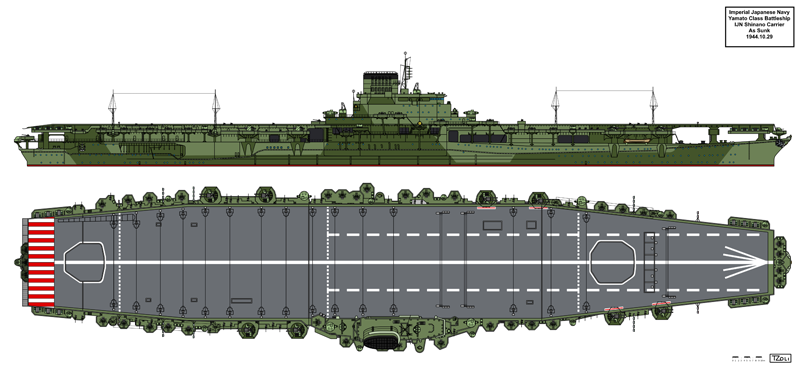
Original 2 view recreation by Tzoli, with her final camouflage, as sunk. Src on behance
Hull
Essentially the very same as her sisters. Only armour figures were changed, thinner in some parts. The hangar was located further aft, as following the deck shape, leaving a relatively long narrower section forward, where the deck was supported by pillars. She carried a few service boats, housed aft in the original hull backwards-facing tunnels unique to this class, and two yawls strapped under davits below the forward main guns sponsons. The rest was composed, like on US ships, of inflatable boats.
Powerplant
IJN Shinano shared the very same powerplant as her sisters: Four shafts with equal size inner and outer bronz three-bladed propellers, connected to four Kampon geared steam turbines, fed each by four (so 12 totam) Kampon water-tube boilers for a total output of 150,000 shp (110,000 kW). According to the usual protection scheme, all single turbines compartments and four boilers compartments were separated and protected by armoured walls in case of flooding. Design speed actually was 27 knots (50 km/h; 31 mph) (other sources states 28) and the rushed service entry of Shinano skipped entirely full-speed sea trials. Internally she carried 9,047 metric tons (8,904 long tons) of fuel oil for an estimated range of 10,000 nautical miles (19,000 km; 12,000 mi) at 18 knots (33 km/h; 21 mph).
The Shinano’s Island
In naval architecture, engineers simply took Taiho as a base model for the new island fitted on Shinano, with adaptations. It was rather large compared to usual practices, and like the Junyo and Taiho, used the now standard exhaust ducting for a large funnel offest to starboard to deflect smoke away from the flight deck. The island was also offest, meaning completely out of the flight deck, on hull support, and comprised five levels. The first one was a lower, more extended superstructure supporting two main Type 94 high-angle fire-control directors fore and aft, and two secondary ones behind “B” main and the other on the bridge’s roof. The enclosed command bridge was on the 4th level and there was an open command bridge above.
In front of the funnel was installed a small radio room and the tripod mast above, supporting radars. For the latter, these were two 1-shiki 2-go radars fitted on the secondary telemeters, and a 3-shiki 1-go main surveillance radar on the mainmast (Type 13 and 22). It is unclear if they had been installed when she was sunk according to photos.
Armor Protection
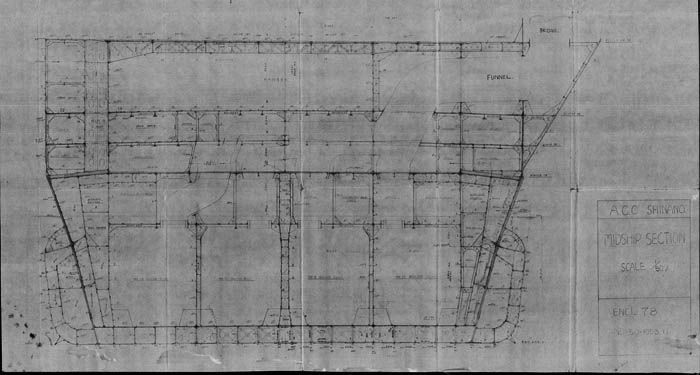
Shinano reconstructed, inverted midship section plan Src
She had a main belt of 6.3 in but on a 0.6 in (15 mm) plating, on 2/3 of hull length. It was closed by 25° sloped downwards 13.38 in (340mm) bulkheads. The 4-in main deck was connected with the main belt by 7° sloped 9 in plating on the outer slopes but increased to 7.5 in over magazines. The Flight deck was protected by a composite of 3.7 in (95mm), a sandwich of 3-in (76mm) plating on 0.7 in (19mm) over the hangar, to block bomb penetration. It was down to 3.14 in (80mm) over the ends forward and aft of the hangar. Lifts had sides 1.96 in (50 mm) thick, Magazines’s armored boxes had walls 7-2.7 in (180-70mm) thick and avgas (aircraft fuel) tanks 7-2 in (180-50mm). The steering gear compatment was protected by 5-2 in (125-50mm) vertical protection. Fun inlets and funnel uptakes were protected by 1.4 in (38mm).
The underwater protection and anti-torpedo bulges remained unchanged, despite now some awareness about US submarines activities, but 300 in (8m) deep with 9-3 in (230-75mm) longitudinal bulkhead. Main gun turrets barbettes were transformed into aviation ammunition elevators, the best engineers could think of. They were too small and awkwardly shaped to be transformed into aviation lifts anyway. The main belt was lightened down to 160 mm (6.3 in) instead of the original 410 mm (16.14 in) and no changes were made to the vertical protection as it was a part of the hull structure itself, the continuation of the armoured anti-torpedo bulkhead, which upper edge was way thicker than the main belt.
Very thick, 230mm (9 in) flat slopes on the main deck over the machinery were downgraded to 100mm (4 in) vs. twice as much on Yamato but magazines kept 190 mm (7.5 in). Protection of the main deck was modelled on IJN Taiho rather than starting with a blank page. The central section of the flight deck, between elevators, corresponding to the original citadel, but shorter, was identical but hangar sides walls remained unprotected. Avgas tanks and the main steering compartments were encapsulated into strongly armoured “boxes”.
As additional protection, double bulkheads were installed with the space between them filled with water or concrete. Thus, this made a total armour weight for an aircraft carrier way above any competitor, no less than 17,694t, plus 2400t of concrete. Underwater protection was essentially the same as Yamato with external bulges, three raked longitudinal bulkheads, a 200mm thick upper edge but it had insufficient breadth although still believed at the time to provide enough underwater protection. It seems in the light of what happened Shinano was not victim of a poor underwater protection design, but poor preparation of the crew to face such emergency.
Armament
In short, IJN Shinano was planned to carry the new 100mm/65 (4 in) guns type 98, the same installed on IJN Taiho. But due to shortages, good old Type 89 5in (127mm)/40 were installed provisionally (still there when she sank). Light AA armament was generous, more than on the Taiho due to her larger hull, leaving plenty of space around for extra mounts. In total, she had 35 triple 25mm Type 96, and later 40 extra single ones, plus twelve 28-barreled 120mm AA rocket launchers were installed. This made her the most heavily armed Carrier of the IJN so far. But it was less than her sisters Yamato and Musashi, against which the same unretentless swarm of USN aircraft would probably has the same effect in the end. She also did not have a sufficient CAP to stop them anyway.
Twin 5 in Type 89 DP guns
Standard dual-purpose gun in service with all IJN carriers up to that point. Unlike IJN Taiho, she was not equipped with the intended new 100mm/65 Type 98, in short supply, and installation of the Type 89 was seen as provisory. The eight mounts were located in pairs fore and aft of below flight deck level, so their fire could not intercross above it. This usual flaw of IJN carrier design was repeated also on the Unryu and Ibuki classes. They were served by four Type 94 high-angle fire-control directors, two installed on either side of the starboard side island and two others on deck sponsons on the port side. detailed specs
Single & Triple Type 96 25 mm AA guns
The staple of light AA in the IJN. In order not to repeat the same specs as on each post, here are the detailed specs in the weapons section. Location of the 35 triple mounts was all around the deck level. They were located in sponsons all along the flight deck, and like DP artillery, lower than the deck, so not capable of crossing fire. In addition to the sides, four were located on the prow, and three at the stern. They were contrlolled by a telemeter located on top of the main bridge roof, close to the mainmast.
120 mm Type 5 AA Rocket Launchers Ro-Sa Dan

These were installed on stern and prow angle side sponsons, for the best firing arc. Development of AA spin-stabilized rockets, inspired by German and domestic works, was a quick and intense firepower solution frvrloprf in 1944. The idea was to cover the largest blast area in the shortest time possible, overwhelming an air attack. On paper it was very efficient since each mount could delivered in rapid succession twenty-eight 5-in rockets, with incendiary shrapnel warheads. The latter were close to the “Sankaidan” Type 3 gun shells. The time fuze had two settings, 1,000 or 1,500 meters (1,100 or 1,640 yards). Maximum Range
was 5,250 yards (4,800 m) and maximium ceiling at 80°, about 7,545 feet (2,300 m). Very few action reports exist on them, so it’s difficult to assess their effectiveness. More on these. ➚ See also the ONI report, p15-16. ➚ or this source (in japanese) ➚.
Hangar, flight deck and facilities
The flight deck was large, a benefit of the original hull, allowing generous parking on either side, in a way no IJN carrier could do in the past. The deck was armoured and inregral part of the superstructure as the original hull was used, the hangar floor was directly on the weather deck. As said above, there was no space for a two-level hangar due to stability issues. Managing the whole air park in a single level meant in the end a ridiculously small air group was operated for the world largest aircraft carrier: Only 42 (47 with spare) aircraft. The flight deck froward of the hangar was supported by pillars above the bow.
Aviation ammunition stowage was however far above the air group and meant to supply many other carriers. It was intended to cover the first line armoured carrier forces and replenishing them with aircrafts and ammunition. All in all, the hangar was 167m long for circa 35m wide, 5m tall, with 10,240m² floor superficy, not with straight sides butr following the hexagonal hull shape. While the flight deck was 256 x 40m for a total of 20,900m³. There were two lifts of unequal shapes and sises, fore and aft of the main hangar: The fore hexagonal lift was 15 x 14m and the aft lift was smaller at 13 x 13 m and more lozenge-shaped. Aircraft fuel stowage was also impressive and beyond the need of her small air group, reaching 718,300 liters of aviation gazoline, well protected into her belly.
Due to the size of her deck she also had no catapult, 15 arrestor hooks, the forwardmost short of the first lift, and four crash barriers, plus a security one for planes taking off, forward. There was also a crane located on the port side aft for recovering splashed aircraft.
Air group of IJN Shinano
Her park as initially planned comprised 47 aircraft, quite weak for a ship of her tonnage, with about 21 A6M5 fighters, and the rest composed of D3A2 “Val” Dive bombers (soon replaced by D4Y “Judy”), B6N “Jill” and later B7A “Grace” Torpedo Bombers, and C6N reconnaissance planes. Exact composition when she made her first sortie is not known, but the generally accepted figures revolves around 21 A6M5 zero, 21 D4Y1 “Judy” and 6 D4Y1C “Judy” dive bombers, so 47 models aboard.

Mitsubishi A6M5 Zero Type 52 Fighter
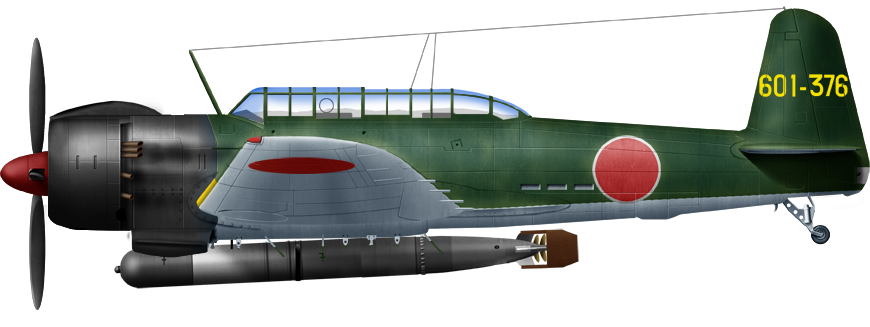
Nakajima B6N Tenzan “Jill” Torpedo Bomber

Nakajima C6N Saiun “Myrt” reconnaissance plane

Author’s illustration of IJN Shinano
⚙ Specs Shinano 1944 |
|
| Dimensions | 266 oa x 36.3 x 10.3 m (872 ft 2 in x 119 ft 1 in x 33 ft 10 in) |
| Displacement | 62,000 t standard, 71,900 t FL |
| Propulsion | 4 geared steam turbines, 12 Kampon boilers, 150,000 hp. |
| Speed | 28 knots (52 km/h; 32 mph) |
| Range | 10,000 nmi (19,000 km; 12,000 mi) at 18 knots (33 km/h; 21 mph) |
| Armor | Waterline belt: 160–400 mm (6.3–15.7 in), Flight deck: 75 mm (3 in) |
| Armament | 8×2 12.7 cm (5 in) DP, 35×3 25 mm AA guns, 12×28-barrel 4.7 in AA RLs |
| Air Group | 47 aircraft |
| Crew | 2,400 |
IJN Shinano’s short career

A botched completion
IJN Shinano as planned as a converted aircraft carrier was originally scheduled for completion in April 1945, when started in June 1942, but construction was expedited to years later in June 1944, rushed after the defeat at the Battle of the Philippine Sea, anticipating bombing runs directly on Japan from the Mariana Islands. Workers being still short, Yokosuka was unable to meeet the deadlines of October. So crucially, she missed the battle of Leyte. Still, pressure to complete her as quickly as possible compounded poor workmanship, botched until her launch on 8 October 1944.
Captain Toshio Abe was first in command, and troubled by an accident which was seen as a bad omen: During the floating-out procedure, one caisson in the dock, not been properly ballasted with seawater to gain time started to lift as water rose and the sudden inrush of water pushed the carrier free into the forward end. As a result her bow was damaged below the waterline. This cancelled the whole procedure, causing the ire of the admirakty. She requiring repairs after her deck was dried again, and a new floating out procedure was made, this time with extra care, successful on 26 October.
On 19 November 1944, Shinano was formally commissioned at Yokosuka, being completed on site, at least partly. The two weeks fitting out was record-breaking, allowed her to depart for her initial sea trials. She never had the time to make proper, official ones. There were U.S. reconnaissance bombers flying over Yokosuka which urged the General Staff to depart for Kure for extra fitting out, and far better protected from attacks. Indeed, Yokosuka was exposed south of Tokyo, to bombing raids, while Kure was well protected inside the maze of well-defended islands between Shikoku and the mainland. To get there was a one day trip.

The world’s only second known photo of IJN Shinano: Taken by a recce B29.
On 28 November, she was supposed to depart, but Abe asked for a delay, as the majority of her watertight doors were not even installed. Compartment air tests had not been made, there were still gaping holes in the compartment bulkheads, leaving space free for electrical cables as well as unsealed ventilation ducts and pipes. Also fire mains and bailing systems lacked pumps. She was not able on paper to pump out water quick enough in case of a flooding. All thise weighted much in Abe’s shoulders. The crew had some experience but lacked training, notably for pumping and safety in general.
Departure on 28 November 1944
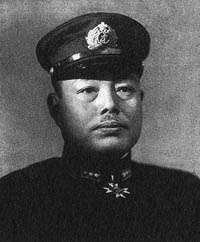 Toshio Abe‘s request was dismissed, and she was to be escorted by the destroyers IJN Isokaze, Yukikaze and Hamakaze, from the Battle of Leyte Gulf. They were also damaged and required three days of repairs as well as crew’s rest. But their captains were denied these request as well. The general staff, obsessed with the air threat, was adamant she was to depart, even unfinished, at the planned date. So she did, at 18:00 on 28 November.
Toshio Abe‘s request was dismissed, and she was to be escorted by the destroyers IJN Isokaze, Yukikaze and Hamakaze, from the Battle of Leyte Gulf. They were also damaged and required three days of repairs as well as crew’s rest. But their captains were denied these request as well. The general staff, obsessed with the air threat, was adamant she was to depart, even unfinished, at the planned date. So she did, at 18:00 on 28 November.
Abe pressed his officers to train hard his 2,175 men, and to gain time, she also carried 300 shipyard workers onboard to fix the most urgent issues, as well as material, spares and and 40 civilian employees from the yard. Watertight doors and hatches were all the time left open for these to more easily access machinery spaces during the trip, while manholes in the double and triple-bottomed hull were also left open, to allow cabling and last minute sealing. Abe choosed to go by day, preferring having most of his crew awake in case of emergency and extra training.
There was however a last minute change: Asking by radio of there was to be an aviaiton support, he learned this was denied. He choosed instead to make a “nighttime run” but her large deck spaces were occupied by six Shinyo suicide boats and 50 Ohka suicide flying bombs for local operations. She did not have her air crew assigned yet. They were planned to come aboard, and qualify in December at best. Her orders were to complete fitting out in Kure and then depart for the Philippines and Okinawa to deliver her kamikaze craft and flying bombs. To spare his engines and navigate in somewhat safer conditions, he choosed to run at 20 knots (37 km/h; 23 mph) while zig-zaging to avoid submarine attacks, instead of full speed, calculating a 16 hours trip for 300 miles (480 km) to Kure. The Naval command placed such hopes in this mission they teased Abe for promotion to rear admiral.
The sinking
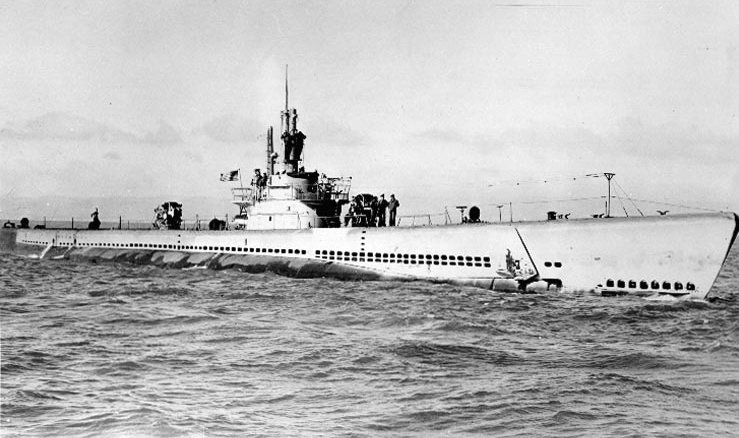
USS Archerfish (launched 28 May 1943)
Enters USS Archerfish. The Balao class submarine was cruising close to Japanese waters, under command of Joseph F. Enright, surfaced by night, when he was informed at 20:48, by his radar operator of several dots, inclusing one quite large, likely a capital ship and escorting destroyers. He choosed to shadow them on a parallel course, maintaining about the same speed with diesels. Over one and a half hours earlier she was more precisely located by radar. She was zig-zagging and turned the task group back several times in the submarine path unknowingly, until at 22:45, the bridge’s lookouts spotted USS Archerfish thanks to the moon’s reflection while speeding up at the surface.
Immediately, IJN Isokaze broke formation against orders to investigate, while Abe frantically tried to ordered her to return in formation. He indeed feared this was a ruse, part of a larger wolfpack. He assumed USS Archerfish was a decoy for his escorts indeed, while ordering a speed increase, hoping to leave some space based on a 2-knot speed advantage. Around 23:22 however, the botched completion started to turn against him: He was informed from the machinery officer that one propeller shaft bearing was dangerously overheating.
He ordered to reduce speed to 18 knots same as Archerfish which was now capable of staying “in the race”, continuing to shadow her. At 02:56 (the following day, 29 November), IJN Shinano turned to southwest in his zigzag procedure, bringing him stright towards the Balao-class. Eight minutes later, the latter submerge while turning east to find the best spot to launch. Cdr. Enright ordered his torpedoes set for 10 feet (3.0 m) knowing some issues related to deviations. He also wanted hits higher up in the hull. Shinano turned south soon aft in its usual manoeuvering, but this exposing her entire side, which was an occasion not to miss. One of the destroyers passed right over Archerfish without detection and at 03:15 Captain Enright ordered to fire all six tubes, before diving to 400 feet (120 m) as the noise was immediately detected this time. He tried to escape a depth charge attack by the closest destroyer, followed soon by the other two. The hammering was fierce.
But it was alredy too late: Four torpedoes out of six struck Shinano on her side, under the belt, at around 4.27 meters (14 ft 0 in). The first hit towards the stern, flooding refrigerated storage compartmentsand empty gasoline storage tanks. The blast also killed all sleeping engineering personnel above. The second hit close to the starboard outboard propeller shaft, precisely where is transitioned into the hull. A gap was formed by the blast, which rapidly flooded the outboard engine room. The third was a bit forward and hit at the No. 3 boiler room. Structural failures had the two adjacent boiler rooms flooded as well, leaving only one operational. The fourth hit the starboard air compressor room, flooded as well as the anti-aircraft gun magazines and second damage control station, while the oil tank next was reuptured and started to spill.

Diagram showing locations of torpedo hits and ensuing flooding: Red shows compartments immediately flooded, orange slowly flooded, and yellow deliberate flooding to offset the ship’s list
The damage was at first judged to be manageable by the satefy officer, and the crew was mobilized to contain the flooding. Between, the carrier’s armor strength and untouched central citadel, the “raft” also counting as a buoyancy reserve, and advantage of battleships, there were hopes to master the damage. As a remainder, IJN Taiho was sunk on 19 June 1944, but it’s not flooding (which was contained) but avgas vapors left unchecked that blew her up long after the torpedo hits.
So knowing this or not, the crew was still confident and initial response was lax. This was contagious as Abe was also soon very confident his ship would hold out, also given the knowledge American torpedoes were quite inferior. Fearing other submarines, he ordered top speed to be maintained, with the effect of rushing more seawater into the holes, and flooding progressed considerable for several minutes. As a result she listed 10 degrees to starboard, while the crew managed to pump out 3,000 long tons into the port bilges, but it still soon increased to 13° and confidence vanished.
It soon became apparent the damage was far more severe than first anticipated and Abe ordered to veer off and reach Shiono Point asap, to try perhaps to beach her. But increasing flooding caused soon a 15° list by 03:30 and 50 min. later, Abe ordered to fill empty port outboard tanks, for counter-flooding, managing to get back to 12°, but it didnt last. After 05:00 AM, he ordered civilian workers to be transferred in the destroyers, as impeding the crew’s efforts.
At about 5:30, later, she was now down to 10 knots, 13° and again 30 min. later, 20°. Indeed the starboard boiler room flooded in turn, port trimming tanks valves becoming ineffective. Engines shut down at this point completely and she was in effect dead in the water around 07:00. Abe ordered all propulsion compartments evacuated and the three outboard port boiler rooms flooded to combat list, but it was too late. Hamakaze and Isokaze were ordered to take her in tow but it was hopeless. Additionally to the enormous displacement, she had taken thousands tons of seawater. This was just impossible to overcoe. A call to help was launched by radio, while tow cables snapped. Fortunately none was injured when it happened, and a second attempt was aborted.
Around 09:00 electricity shut down and the crew was down to portable pumps, with a small output, and little training to use them. Nothing could prevent the list to go beyond 20 degrees and at 10:18 she reached ten more, at least, Abe ordered to abandon ship. While she heeled, water started to enter all her porthiles and then the flight deck open elevator well. The succion was enough to catch many swimming away sailors back into her, trapping them to death. A large exhaust vent below the flight deck also rupture by pressure and according to testimonies, did the same. At 10:57 she eventually capsized and disappeared stern-first 65 miles (105 km) from the nearest land.
There, she sat eventually under 4,000 meters (13,000 ft) with still 1,435 officers, men and non evacuated civilians aboard. Abe and both of his navigators choosed to go with her as well. 55 officers were rescued, trying their best to managed 993 petty officers and enlisted men. 32 civilians also had been evacuated, less than half the crew. In conformity to the usual IJN policy, they were all isolated on the island of Mitsuko-jima until January 1945, not to pread the news of the tragedy. She only was formally struck on 31 August.
US take on the sinking and post analysis
US Naval Intelligence -USNI) was highly dubious of Enright’s claim to have sunk a carrier, late alone this one. Her construction has been kept secret well, and no analyst believed in her existence while the position of all other carriers was well known. There was still the testimony back in July 1943 of a third Yamato class in construction, being converted as a carrier, and instead, Enright was credited wwith the Hiyo class 28,000-long-ton IJN Hayatake by the commander of the Pacific Fleet’s submarine force (COMPSUB) based on Enright’s drawing. It took post war years to see him properly credited with the sinking of Shinano, earning him a Navy Cross.
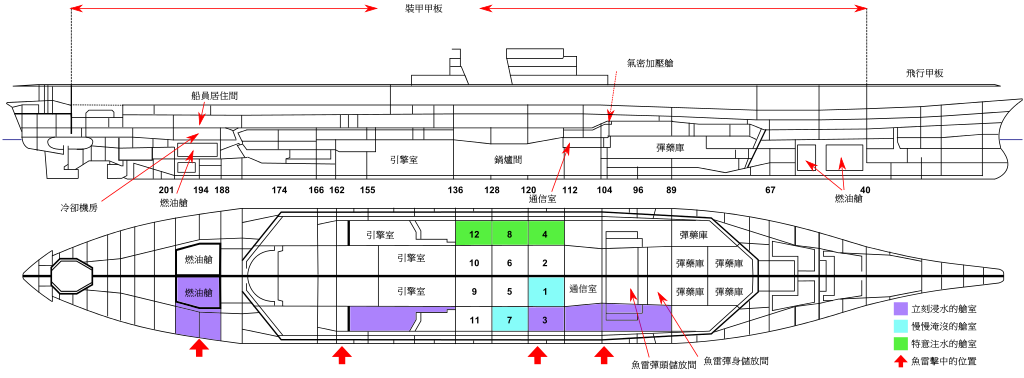
Another take on the damage, with the impacted zones.
Analysis by the US Naval Technical Mission to Japan of surviving plans after the war, highlighted serious design flaws:
-Poorly designed Joint between the waterline armor belt (upper hull) and anti-torpedo bulge underwater (basically shared by other Yamato class vessels).
-I-beam disjointed by the blast in one boiler room, holing another.
-Intested water-tightness of the compartment (potential leaks were left unchecked)
-Improper training and as said above, missing doors and hatches to complete work in time, as extra flooding points
-The surviving executive officer testimony, blaming also the to compartment leaks tests, remembering gushes of air rushing through gaps minutes after the last torpedo hit.
-Underevaluation of the risks by the captain and safety staff in the hours following the hits: Top speed leading to more flooding, and weak initial answer until power was lost.
Her executioner, USS Archerfish (SS-311) would have a long postwar career. Not converted as a GUPPY she still managed after winning in WW2 seven battle stars and a Presidential Unit Citation, to serve until 1968, notably making valuable oceanigraphic researches until 1964. When she sank Shinano ot was her fourth patrol, followed by two more until V-Day.
Sources/ Read more

Hull plans lines in B&W, see the very heavy HD (25 mo) original blueprint hosted on the National Archives and Records Administration.
Books
Conway’s all the worlds fighting ships 1922-1947
Blair, Clay (2001). Silent Victory: The U.S. Submarine War Against Japan ([1975] ed.). Annapolis, NIP
Brown, David (1977). WWII Fact Files: Aircraft Carriers. New York: Arco Publishing.
Campbell, John (1985). Naval Weapons of World War II. NIP
Chesneau, Roger (1995). Aircraft Carriers of the World, 1914 to the Present: An Illustrated Encyclopedia, NIP
Enright, Joseph F. & Ryan, James W. (1987). Shinano!: The Sinking of Japan’s Secret Supership. NY St. Martin’s Press.
Garzke, William H. & Dulin, Robert O. (1985). Battleships: Axis and Neutral Battleships in WWII. NIP
Jentschura, Hansgeorg; Jung, Dieter & Mickel, Peter (1977). Warships of the Imperial Japanese Navy, 1869–1945. NIP
Preston, Anthony (1999). The World’s Great Aircraft Carriers. London: Brown Books.
Silverstone, Paul H. (1984). Directory of the World’s Capital Ships. New York: Hippocrene Books.
Stille, Mark (2007). USN Carriers vs IJN Carriers: The Pacific 1942. Duel. Vol. 6. Oxford, UK: Osprey Publishing
Links
Shinano: The Jinx carrier, by Lynn Lucius Moore, Journalist, Second Class, U.S. Navy (Proceedings 1953)
Tully, Anthony P. (2001). “IJN Shinano: Tabular Record of Movement”. Kido Butai. Combinedfleet.com.
Holtzworth, E.C., Commander (January 1946). “Reports of the US Naval Technical Mission to Japan: Ship and Related Targets
cnrj.cnic.navy.mil
On militaryfactory.com
On dvidshub.net
On navypedia
Wiki
The model’s corner

Boxart
Nice 2D views by Tzoli
Splendid 3D views by Waldemar Tubus Góralski

As the largest aircraft carrier in the world, the Japanese Navy Shinano had a short but legendary service life, carrying the rise and fall of the Japanese Navy during World War II, and has a very high historical commemorative value.
For military enthusiasts, historical researchers, and related collectors, the story of the Shinano is worth remembering, and customizing military challenge coins is a very distinctive and meaningful choice.
You can incorporate some classic military elements, commemorative patterns, texts, etc., into the design of Custom Challenge Coins. Such personalized challenge coins are not only a beautiful collection but also a commemoration and tribute to this period of military history.

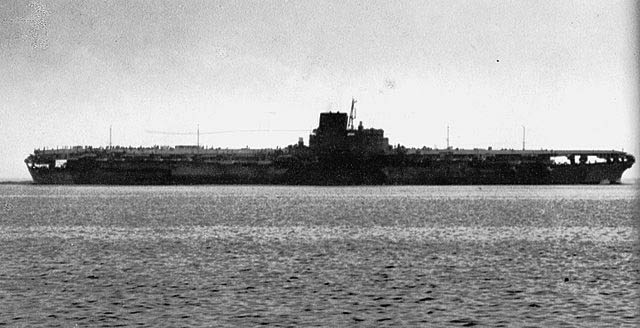
 Latest Facebook Entry -
Latest Facebook Entry -  X(Tweeter) Naval Encyclopedia's deck archive
X(Tweeter) Naval Encyclopedia's deck archive Instagram (@navalencyc)
Instagram (@navalencyc)





 French Navy
French Navy Royal Navy
Royal Navy Russian Navy
Russian Navy Armada Espanola
Armada Espanola Austrian Navy
Austrian Navy K.u.K. Kriegsmarine
K.u.K. Kriegsmarine Dansk Marine
Dansk Marine Nautiko Hellenon
Nautiko Hellenon Koninklije Marine 1870
Koninklije Marine 1870 Marinha do Brasil
Marinha do Brasil Osmanlı Donanması
Osmanlı Donanması Marina Do Peru
Marina Do Peru Marinha do Portugal
Marinha do Portugal Regia Marina 1870
Regia Marina 1870 Nihhon Kaigun 1870
Nihhon Kaigun 1870 Preußische Marine 1870
Preußische Marine 1870 Russkiy Flot 1870
Russkiy Flot 1870 Svenska marinen
Svenska marinen Søværnet
Søværnet Union Navy
Union Navy Confederate Navy
Confederate Navy Armada de Argentina
Armada de Argentina Imperial Chinese Navy
Imperial Chinese Navy Marinha do Portugal
Marinha do Portugal Mexico
Mexico Kaiserliche Marine
Kaiserliche Marine 1898 US Navy
1898 US Navy Sovietskiy Flot
Sovietskiy Flot Royal Canadian Navy
Royal Canadian Navy Royal Australian Navy
Royal Australian Navy RNZN Fleet
RNZN Fleet Chinese Navy 1937
Chinese Navy 1937 Kriegsmarine
Kriegsmarine Chilean Navy
Chilean Navy Danish Navy
Danish Navy Finnish Navy
Finnish Navy Hellenic Navy
Hellenic Navy Polish Navy
Polish Navy Romanian Navy
Romanian Navy Turkish Navy
Turkish Navy Royal Yugoslav Navy
Royal Yugoslav Navy Royal Thai Navy
Royal Thai Navy Minor Navies
Minor Navies Albania
Albania Austria
Austria Belgium
Belgium Columbia
Columbia Costa Rica
Costa Rica Cuba
Cuba Czechoslovakia
Czechoslovakia Dominican Republic
Dominican Republic Haiti
Haiti Hungary
Hungary Honduras
Honduras Estonia
Estonia Iceland
Iceland Eire
Eire Equador
Equador Iran
Iran Iraq
Iraq Latvia
Latvia Liberia
Liberia Lithuania
Lithuania Mandchukuo
Mandchukuo Morocco
Morocco Nicaragua
Nicaragua Persia
Persia San Salvador
San Salvador Sarawak
Sarawak Uruguay
Uruguay Venezuela
Venezuela Zanzibar
Zanzibar Warsaw Pact Navies
Warsaw Pact Navies Bulgaria
Bulgaria Hungary
Hungary

 Bundesmarine
Bundesmarine Dutch Navy
Dutch Navy Hellenic Navy
Hellenic Navy Marina Militare
Marina Militare Yugoslav Navy
Yugoslav Navy Chinese Navy
Chinese Navy Indian Navy
Indian Navy Indonesian Navy
Indonesian Navy JMSDF
JMSDF North Korean Navy
North Korean Navy Pakistani Navy
Pakistani Navy Philippines Navy
Philippines Navy ROKN
ROKN Rep. of Singapore Navy
Rep. of Singapore Navy Taiwanese Navy
Taiwanese Navy IDF Navy
IDF Navy Saudi Navy
Saudi Navy Royal New Zealand Navy
Royal New Zealand Navy Egyptian Navy
Egyptian Navy South African Navy
South African Navy






























 Ukrainian Navy
Ukrainian Navy dbodesign
dbodesign
I am confused on one thing after reading this article: I understand that she did not, but was she able to carry some od 100 planes or not?
Hi Søren R, the official figure is 47, based on available space in the armoured hangar. That’s less than the Implacable class, which was smaller (48). 100 could be achieve perhaps when taxiing aircraft (flight deck full) with perhaps c70 when using actively the flight deck (additional deck park). Again, it was 81 for an Impacable class. Not impressive overall. These figures of course depends on the models carried, testing scale models on the deck would cure the debate.